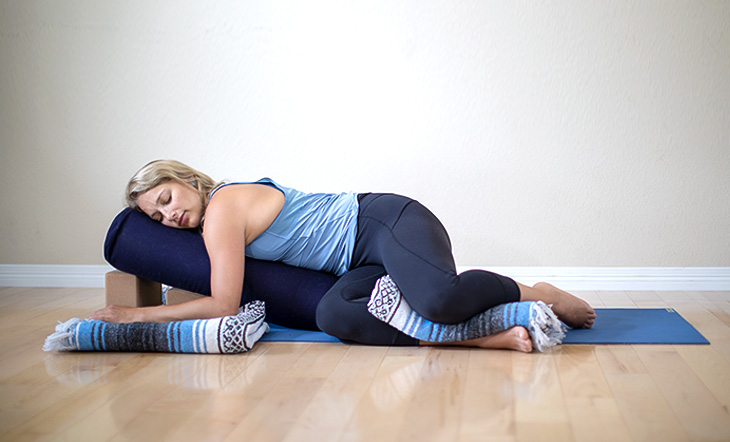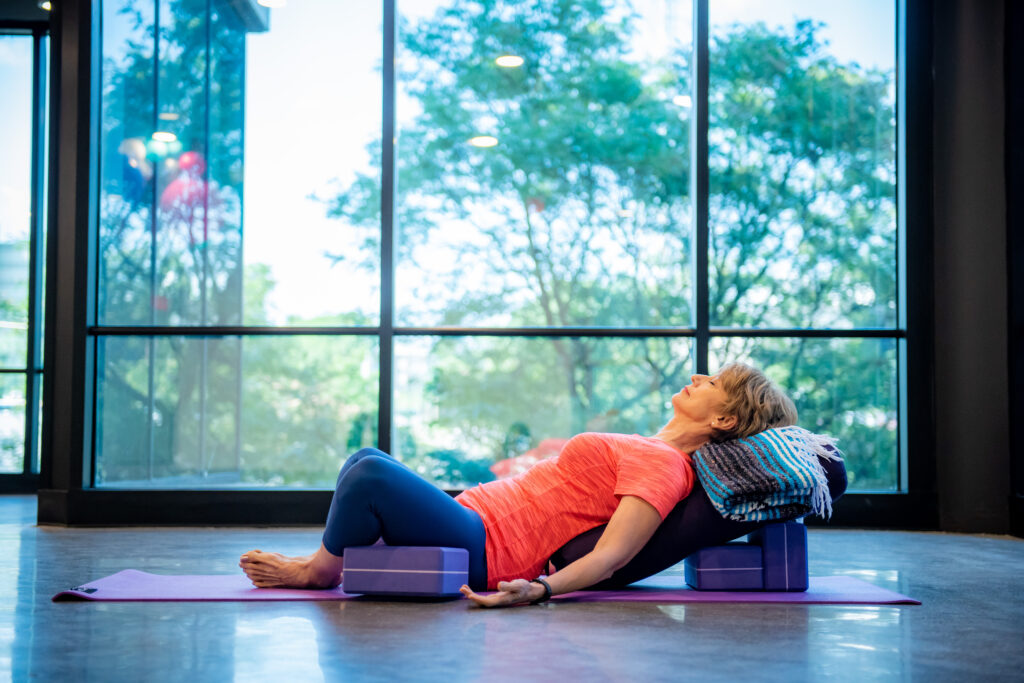Did you know yin yoga and restorative yoga are not the same thing? From the outside, the practices look similar – they both include long holds, utilize props, are slow and introverted practice, and focus on opening the body over time instead of through dynamic movement.
If you are wanting a restful yoga practice to help you decompress and relax, which one do you choose?
As a yoga teacher of both styles, I get asked this question often. Restorative and yin look very similar from the outside. However, when you learn their origins and the essence of the practice, you will quickly learn they are quite different.
The History of Yin & Restorative Yoga
Restorative yoga and yin are both relatively new yoga styles popularized within the past 50 years, but they come from two different lineages.
Restorative yoga was founded by B.K.S Iyengar in the 1950s and falls under the umbrella of Hatha Yoga. Hatha is an ancient form of yoga with origins in India intended to stretch and strengthen the physical body in preparation for seated meditation. It was created as a practice for students to be able to work on their alignment in postures through long holds but take the pressure off their bodies and muscles. The use of props allows the student to rest and relax.

This practice was popularized by Judith Lasater with her book, Relax and Renew: Restful Yoga for Stressful Times, published in 1993. Judith is a disciple of Iyengar Hatha Yoga and one of the co-founders of Yoga Journal.
Yin yoga has its roots in the ancient Taoist tradition of China and draws upon the doctrine of the five elements and the principles of yin and yang used in Chinese medicine and acupuncture. Paulie Zink started the tradition in the late 1980s to balance the yang style of Hatha yoga. Yin yoga is designed to help open up the fascia (connective tissue) to improve flexibility and mobility through long holds.
More recently this practice has been popularized by Paul Grilley, Bernie Clark, and Sarah Powers, who have each put their own spin on the practice.
Yin Yoga & Benefits
Yin yoga is a practice that focuses on stretching your connective tissues (fascia, ligaments, tendons, and joints). It goes past the point of being comfortable but stops short of actual pain to strengthen and lengthen them. Poses are traditionally held for 3-5 minutes each and work with the energy meridians in your body. The aim is to stress these tissues by offering gentle, sustained traction, compression, or shearing.
The best time to practice yin is when the muscles are cool so they do not steal the stretch away from the deeper tissues. Other good times to practice are early in the morning to help wake up the body or last thing at night to calm the mind before sleep. You may find this practice to be very beneficial when you need to find balance in the mind/body and life has become very hectic, or you return from a long trip.

Yin yoga is best for:
- Increasing flexibility and range-of-motion
- Keeping joints healthy and mobile
- Improving posture
- Improving focus and concentration
- Releasing trauma and emotion stored in the connective tissues of the body
- Calming the mind and bringing your negative thought patterns into your awareness so that you can work with them and release them
Restorative Yoga & Benefits
Restorative yoga is defined as a practice that uses props to create positions of ease and comfort that facilitate relaxation and health. It is a practice for people of all ages, at all levels of yoga experience, and in all states of health. Restorative yoga is about opening, not stretching, and calming the nervous system bringing us back to our “rest and digest” state.
Poses are traditionally longer – anywhere from two to 20-minutes and bodies are supported with props such as blankets, bolsters, and blocks. This creates an atmosphere of ease and calm allowing students to drop into a state of deep relaxation and stillness.
The best time to practice restorative yoga is anytime you have the space and time to practice. Restorative yoga can be practiced morning, noon, or night. You may like to practice first thing when you wake up to get your day started on a positive note, gently waking up the body and mind. You may like to practice after an aerobic workout stretching the muscles after exertion. Or you may like to practice as part of an evening wind-down routine preparing for a good night’s sleep.
Restorative yoga is best for:
- Increasing relaxation
- Improving sleep
- Creating a sense of safety in the mind and body
- Improving mental and physical well-being
- Decreasing blood pressure and heart rate
- Reaching a state of mindful rest
- Cultivating contentment
- Reducing pain

The Difference Between the Two
These practices are alike in the sense that they are slow, meditative practices focused on long holds. So how do they differ?
Rachel Land, a Yoga Medicine therapeutic specialist explains, “Both emphasize the deliberate practice of stillness as a counter-practice to the busy activities of daily life. Both involve long-held, passive, floor-based poses sometimes utilizing the support of props like bolsters, blankets, blocks, and straps. Many poses appear in both yoga styles. However, the intention and internal experience of the two styles are completely different.”
Yin yoga invites you to go deeper into your deep tissue fascia and involves some level of sensation in the targeted tissues. Even though props can be used to support the body, the focus of the practice is to learn to be with the sensations in stillness and witness our emotional response to them.
Yin yoga is extremely beneficial for students who want to increase their flexibility, mobility, and cultivate their joint and tissue health. This can be a wonderful style for many but should be practiced with caution for students who have joint injuries, tissue damage, or struggle to get up and down from the floor.
Restorative yoga is designed to hold and support your body 100% so you are exerting very little effort and can completely surrender into the pose. The set-up may take some practice figuring out how many props to use and where to place them, but the payoff is a much longer stay in the pose allowing both the mind and body to move into a deep state of rest and relaxation.
Restorative yoga is extremely beneficial for students who need to slow down, rest, and turn inward. It can be a great compliment for students who are physically active in other ways, who may be a part of an intense training routine and needs rest days, or someone who is mentally or emotionally worn down and burnt out.
Quick Reference to Differences
Stretch: In yin yoga, there is an active stretch but in restorative yoga, the goal is to be 100% supported and passive with no active stretch.
Focus: In yin yoga, the focus is on stretching your connective tissues but in restorative yoga, the focus is on the passive release of mind-body tension with a gentle stretch to the muscles.
Props: Both styles may use props but in yin yoga, if props are used, they are used to either deepen or soften the stretch. In restorative yoga, props are used to completely support your body. Generally, restorative yoga will use far more props than yin, which may include straps, blankets, blocks, sandbags, and bolsters.
Poses: Yin yoga poses are held for about 3-5 minutes, while restorative yoga poses are held for anywhere from 5-10 minutes.
There is room in your yoga practice for both practices. I encourage you to try a class or two, experiment and see which one helps you find that sense of calm you deserve.
Join me for a Yin Yoga class on the first Monday of every month from 5:30 – 6:30 pm CST. My next yin yoga class is Monday, June 6th. You can also join a Restorative Yoga class on the Monday closest to a season change (i.e., Summer Solstice, Fall Equinox, Winter Solstice, Spring Equinox) from 5:30 – 6:30 pm. My next Restorative Yoga class is Monday, June 20th. The recordings are available on-demand in the Lotus Library for members.

